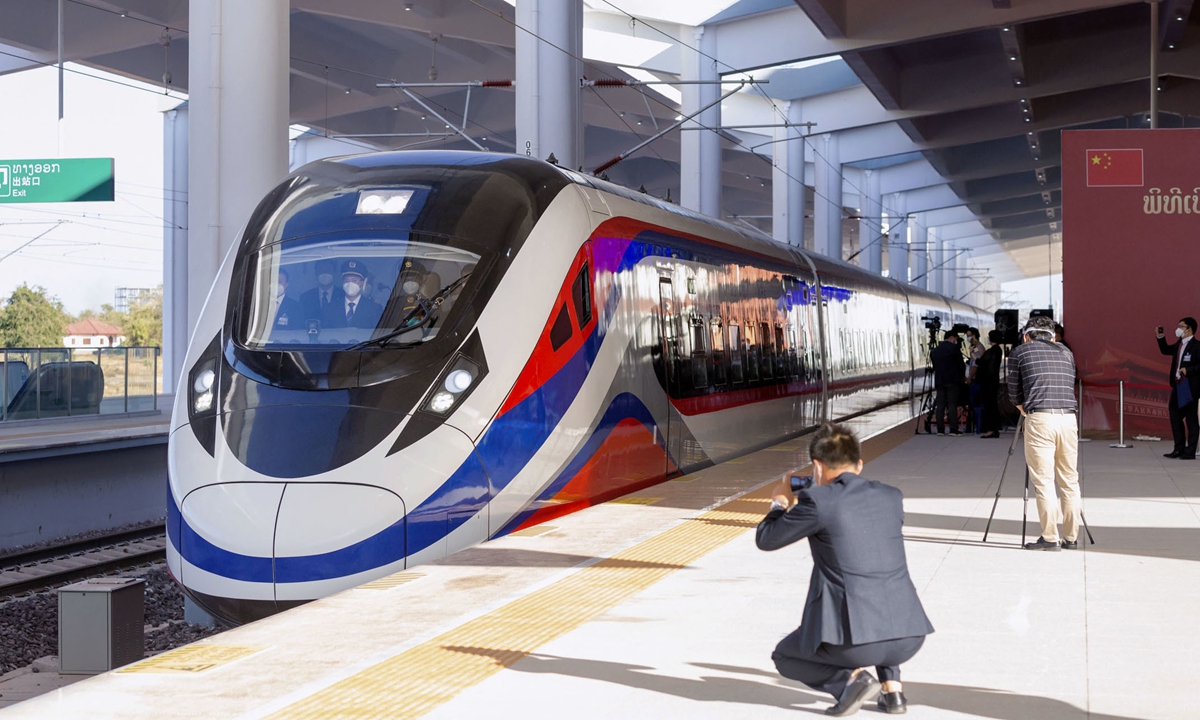
The first international cargo train along the 1,035-kilometer China-Laos Railway arrives in Vientiane, Laos, on December 4, 2021. The signature project, under the China-proposed Belt and Road Initiative, officially went into full operation on December 3. Photo: VCG
Traveling from Jinghong city, Xishuangbanna Dai Autonomous Prefecture, to Vientiane, Laos, by high-speed railway, is a journey through lush greenery, with distant mountains, nearby forests, rice fields, and cultivated cows interwoven into a beautiful idyllic scene.
The China-Laos Railway spans 1,035 kilometers, running from the southwest of China to the north of Laos. The completion of this railroad marks a significant milestone in the China-proposed Belt and Road Initiative (BRI).
Eleven years ago, I crossed the river from Chiang Khong in Thailand to Houayxay in Laos and returned to Xishuangbanna, China, via the Kunming-Bangkok Highway. At that time, the highway had just been opened to traffic. Some villages I passed through had very dilapidated houses with many bamboo and wooden hammocks.
This time I saw some villages beside the China-Laos railroad. There were many newly built tiled houses, and many others were under construction. Of course, this is only a superficial change.
While talking with a Thai tourist on the train, he said that with this railroad, many Thai people are now traveling to Vientiane to take the train to China for both leisure and business purposes because it is so convenient. They are also eagerly anticipating the connection of this railroad to Thailand as soon as possible.
Rail transportation has not only reduced transportation costs but also shortened the time. It now takes only two days for durian to arrive Chongqing, China, from Laos.
Lim Wai Hoong, CEO of BIC Bank in Laos, told us that the railroad has facilitated the transportation of more than 1 million domestic and international tourists in Laos since its opening in December 2021.
Additionally, the railway has employed more than 3,500 Laotian staff and created over 100,000 jobs indirectly by catalyzing progress in logistics, transportation, trade and commerce, tourism and other sectors. In the 18 months since its opening, the railway has shown a dynamic trend in both passenger and cargo volume, sending a total of 16.4 million passengers and 21 million tons of cargo, according to a report issued by Chongyang Institute for Financial Studies, Renmin University of China.
The people are highly practical, and desire to see improvements in their lives, as only such changes can instill hope for the future. This is also the theme of the BRI.
The BRI aims not only to connect people and facilitate logistics but also to empower the people of Laos, a landlocked country, by providing them with a vision of the future and the opportunity to embrace modernization. Laos is one of the most economically backward among the 10 ASEAN countries, with a GDP per capita of about $2,550 in 2021, which is one-fifth of China's.
When Laos activates and keeps up with the tide of development in Southeast Asia, the local people benefit, China benefits and the whole of Southeast Asia benefits. We do not avoid the fact that this railroad is strategically important and an essential step in constructing the Trans-Asian Railway network.
When this railroad started to be built, many Western experts warned that it would be a giant debt trap set by China for Laos. Lao Deputy Prime Minister Kikeo Khaykhamphithoune told us that the railroad the Chinese company helped build has accelerated travel for Laotians and changed people's lifestyles and perceptions. How can there be such a good trap?
The "debt trap" narrative soon became the laughingstock of our after-dinner conversation. We are talking about how to make this railroad better serve the people and become a "new energy" that directly improves their lives.
The China-Laos Railway will be extended. Whether it continues along Laos to the south, enters Cambodia and connects with Sihanoukville Autonomous Port, or directly enters Thailand from Vientiane and connects with Bangkok, the railroad, as a tool, will definitely contribute to the improvement of economic development and benefit the people of all countries along the route. This is the most significant strategic significance of the China-Laos Railway.
The author is a senior editor with the People's Daily and currently a senior fellow with the Chongyang Institute for Financial Studies at Renmin University of China. dinggang@globaltimes.com.cn. Follow him on Twitter @dinggangchina




